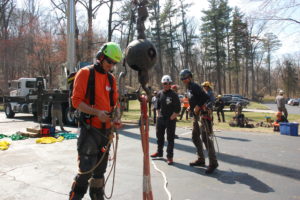The unescapable path to success is hard work. And lots of it. Sometimes it is enjoyable, and sometimes it is not. Any arborist could agree. What’s very important is developing a schedule of getting things done. Everyday. Putting things on a to-do list, and checking them off, one by one. Specialization and fine tuning and balance refine this process as you approach goals, deadlines, and scheduled dates of arrivals. These facets help display the true art in process: efficiently applying the right tools to the right job. More than ever I think about how important it is to get some work done.
Maybe it’s because I heard a blip the other day somewhere on the internet, someone quoting Confuscious as having said, “A person has two lives, and the second starts when they realize they only have one.”
Maybe that quote somehow caused this hysteria, this specific urgency to get things done. There is nothing like the internet for that, I’ll tell you.
But another text that has recently brought this theme to light for me is a wonderful read by author Anne Lamott, Bird by Bird: Some Instructions on Writing and Life. Although the book is written for writers, I can appreciate a lot of the advice as it may apply to the working arborist and their journey towards success.
Lamott offers excellent insight into dealing with the overwhelming burden of being successful in our endeavors. One early chapter in particular is dedicated to breaking the process of writing down into short assignments. Lamott offers us the approach of simply starting with writing what you can see through a small picture frame. Another particularly perfect passage from this chapter is actually a quote: “E. L. Doctorow once said that ‘writing a novel is like driving a car at night. You can see only as far as your headlights, but you can make the whole trip that way.'” (Lamott, 18).
I really loved this quote in as far as it applies to the business of arboriculture too, and not just writing. It illuminates the necessity of focusing on the immediate things that we can see in order to guide us. I can appreciate this sentiment as it to the bare field work as well: tree inspections, climbing, rigging and even working hazardous situations. Many of those situations remind me of driving in the dark, not being able to see too far ahead. Careful and aware though, many times when we know what we’re looking for, we don’t pass the exit. Of course, there is always uncertainty crouching up ahead, and we need to be constantly scanning the ever important horizon for a pothole in the road, or a bounding deer from the bushes beside the road-a girdling root, vascular staining, leaf drop or marginal necrosis or included bark. It’s about having the capabilities to react, rooted in the process of just simply driving, observing and reacting to the immediate things we come into contact with.
Writing is in fact very similar to arboriculture in that sense: one word at a time, one tree at a time. But in this process of cultivating a culture of what I’ll term high-volume arboriculture, we need to have the endurance to withstand it, in order to not strain the system. Endurance is one trait that I truly believe in. I think it is so very important to any artisan that is after some sense of mastery. And also I believe that endurance is the true ticket to success-in writing, in business, in arboriculture. Without it, we just get passed by on the side of the trail, sucking wind and out of gas.
Endurace is in some sense just a cultivation of the process of the things we love to do. In another text I’ve gotten my hands on, The Uphill Athlete by authors Steve House, Scott Johnston and Kilian Jornet, Jornet writes an autobiographical essay titled The Roots of My Athleticism. Jornet is by any reasonable consideration a glowing example of a successful endurance athlete. In his essay he shares that endurance and moving through the landscape through running and skiing and biking was just the culture in which he lived. It was a life passed down to him from his parents. At three Jornet was doing 3,000 metre peaks. At ten, a forty day journey across the Pyrenees. He went on to study anatomy and human physiology at Font-Romeu in France. It’s no wonder he is one of the great modern endurance athletes. He has put in long, hard hours. He admits of himself, “With both book learning and learning from my coaches, I built up the knowledge that allows me to understand the expected effect on my body that will result from every training day. I understand why I can go long easily. Why I recover well. I’ve been a student of myself, my own reaction to training, as well as the science,” (Jornet, 72).
So then endurance is not so much a race as it is an exploration. As Jornet is described in a note from the editor, “he conceives of sport as a way to discover the landscape both inside and outside himself,” (67). That feeling is certainly mutual.
I love arboriculture for that same basic reason. It is, in fact, a great way to discover the landscape both inside and outside ourselves. This is the great challenge, of course. It offers that chance to push both physical and mental boundaries. And not only does it provide a path towards better understanding ourselves, but other as well. By enduring those long sessions of climbing, or stump grinding, or just dragging that brush, we are becoming ever more efficient in blending the landscape of ourself with the landscape that we work in.
Breath by breath, bird by bird, tree by tree. It’s all that hard work that pays off.





Leave a Reply
Your email is safe with us.